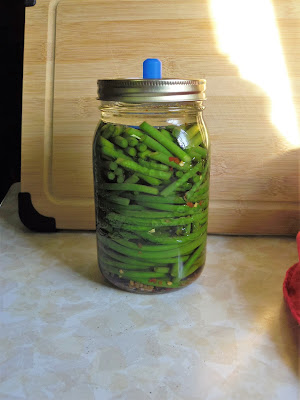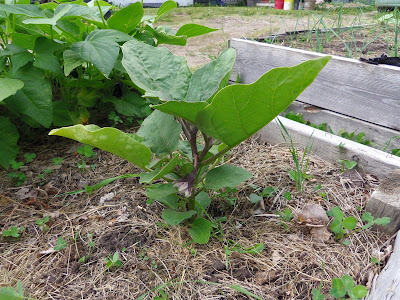June has flown by. Things in the garden seem to have their feet under them now and are growing in earnest. Smoke from the wildfires in the region continued to be an almost constant presence for the first half of the month. Now, it is sporadic; some days are clear, breezy, and fresh with a beautiful blue sky. Others are thick and hazy, with the smell of smoke permeating everything and a sticky, "close" feeling in the air, similar to humidity.
By mid-June, all but two of the cabbages were killed by root maggots in the raised bed. Arhg! It has been years since we last dealt with root maggots. The leeks and bachelor buttons in the same bed seem to be fine. I planted beans (Tendergeen and Roma II) and some Swiss Chard seedlings to fill in the gaps. It's disappointing that we won't to have lots of home-grown cabbage this year for making sauerkraut and my favourite cabbage roll casserole.
Some sort of insect has been chewing on the Swiss chard seedlings and, earlier in the month, the newly emerging bean
plants. They even chewed off the tips of basil seedlings, though the basil is
pulling through.
Volunteer marigolds, sunflowers, peas, and squash popped up all over the place. Cleaning up at the end of the season last year, I stacked plants in a corner of the South garden that is very shaded. Typically, that corner is used as a compost area, and the plants are put in the bottom of the raised beds when they're turned the following year. Often, we'll top up containers and raised beds with soil from this area of the south garden, too. Having so many volunteer marigolds, sunflowers, and peas have come up tells me how mild our winters have become compared to the way they were up until ~10 years ago. Before, the winters were cold enough to have killed the seeds. The volunteer squash are growing from the seeds of ones we composted this Spring. We've had to pull them out when they emerge, but it's been fun to see new ones in the raised beds almost every other morning in the second half of June.
Around June 13th, R. noticed that the garlic scapes were beginning to develop. By June 20th, the Porcelain and Purple Stripe varieties (many curled scapes) were well ahead of Rocamboles, which had almost no scapes. By June 24th, most of the Red Russian, Northern Quebec, and Central Siberian scapes were harvested. The Brown Tempest, Kiev, and Baba Franchuk’s scapes were just starting to show.
June 21st, I harvested some scapes and bottled them in brine to ferment.
Last summer, I canned pickled garlic scapes using this recipe from the Practical Self Reliance blog. They turned out to be tasty and they stored well. The recipe is copied out below.
June 24th, more scapes (a pint jar's worth) were ready to be harvested. I decided to try a cold-packed/refrigerator version of pickled scapes using this recipe. I'll know in two or three weeks how it turned out.
The first tomatoes to develop this summer were....
EM-Champion (June 17)
Favorie de Bretagne (June 20)
On June 21, I found another - larger - Favorie de Bretagne on a different plant.
Two little Black Sea Man tomatoes spotted on June 21.
June 23 - Reinhard's Chocolate Heart and Mongolian Dwarf were starting to develop little tomatoes.
June 25 - The Hungarian Hearts were starting to develop their first tomatoes.
Here are some photos showing where things stand in the garden as of June 25. (Click to enlarge.)
North garden: AmaRosa fingerling potatoes along the bottom left-hand corner, zucchini next, then several rows of snap beans, then the garlic patch in the upper right-hand corner of the picture. Calendula along the back of the garden, and a Dragon's Egg cucumber plant growing beneath the spiral trellis.
The garlic patch, in the North garden this summer.
The South garden: a row of Green Beauty Snow peas (left side of picture), potatoes (Yukon Gold, Norland Red, and Bellanita fingerling), comos, and kale (right side of picture). Marigolds and sunflowers sprinkled throughout! A zucchini (Fordhook) and an egglant (Diamond) in the round, blue containers. Manure tea in the blue plastic totes.
Kale (Rainbow Lacinato)
South side tomatoes, cucumbers, and dry bush beans.
Tomatoes (Black Sea Man, Principe Borghese) and potatoes beside the North garden wall.
I bought way more fingerling tomatoes than we had space for in the main gardens. Bags and totes to the rescue! R. tried a growing technique he learned about online and it seems to be working well. The bags and tote - all with drainage holes in the bottom - are sitting on top of 5 inches of compost and old leaves. This allows for better drainage and the roots of the plants are able to grow out of the bags and into the compost, accessing additional nutrients.
Potatoes, dry bush beans, the neglected flower bed, and a Moonglow tomato. It looks pretty ratty right now. Health issues are making it a real challenge to maintain the garden as well as I'd like.
The poppies started to open the last week of June. These are a mix of Ladybird poppies (red with large, black spots on the petals) and a frilly-petaled version of the same. Today (June 27th), a few Frosted Salmon peony poppies are beginning to show. They should open in the next week or so. It's a gorgeous variety, and I'm looking forward to them blooming in all their glory. :)
Fred's Tie-Dye tomato (a dwarf variety) and dry bush beans (Weiner Trieb and Early Warwick).
Diamond Eggplant
Galeux D'Eysines squash (C. maxima). There are also a few sunflowers (deliberately planted) and peas (volunteers) growing in this bed. An Early Yellow Prolific summer squash is growing in the white container.
More AmaRosa fingerling potatoes in the white container, onions in the bed beside it, then Mongolian Dwarf tomatoes and dry bush beans (Coco Jaune de Chine), then Principe Borghese tomatoes and Heritage Mix dry bush beans (they will have runners, thus the stakes).
Mongolian Dwarf tomatoes. I'm glad I decided at the last minute to include these in my 2023 tomatoes. They grow close to the ground and seem to grow "out" rather than "up". No staking is needed. Had I known how much they would sprawl, I would have spaced them further apart.
The calendula (Pacific Beauty Mix) are about to open.
To my surprise, the Favorie de Bretagne tomato plants have a growth habit and appearance similar to Mongolian Dwarf! I caged them, expecting they'd grow 2.5 feet tall. There are plenty of flowers on these squat plants. There must be more than one strain of this variety. Some descriptions I have read resemble what I see in my garden. Others show plants that are 2-3 feet tall. Some show fruit that are very oval/rounded, while others show fruit that is pointed and elongated (this is what I have).
The East garden: tomatoes along the edge closest to the driveway (Favorie de Bretagne, Fisher's Earliest Paste, and Petrusha Ogorodnik), then several rows of peas, an Uluru Ochre tomato in the near corner, and a Dragon's Egg cucumber beneath the spiral trellis. Calendula and strawflowers are also planted in this garden.
The strawberry bed (with rosemary, a dahlia, a Favorie de Bretagne tomato, an aster, and buckets of aged manure/dirt around it).
Some of the strawberry plants we bought this year have such pretty flowers - almost like tiny tea roses.
Behind the house: cosmos and Fernleaf dill in the round container and Bush Delicata squash in the raised bed behind it.
Gaspé Flint corn in the foreground (it started showing silks June 26th), Principe Borghese tomato in the bright blue container, and cinnamon basil, curly kale, and some struggling Swiss Chard seedlings in the dark, round container in the back. All but the corn are growing in partial sun, so we'll see how they do in the long run. In the black bucket on the right side of the picture is one of R's potato experiments.
The shaded herbal bathtub. Top left (round, white pot) Corsican mint. Right side of tub, a red begonia. Planted in the tub: kale, a nasturtium or so, Indian Tea mint, and Chocolate mint (I think!)). Along the front, L-R: marjoram, Mojito mint, oregano, Woolly thyme. In the small, tan, square container on the left corner of the tub is a bit of Woolly thyme that is waiting to be potted.
This, ironically, is mint from a tranplant I overwintered and several times thought wasn't going to make it. It's thriving, now! I can't recall if it is chocolate mint or lime mint. A focused sniff-test might be in order.
The pickled scapes recipe mentioned earlier in this post:
Canned Pickled Garlic Scapes (printable recipe).
Ingredients
- 1 pound garlic scapes
-
2-3 teaspoons dill seed, one teaspoon per jar (fresh dill can be used, if preferred)
- 1 to 1.5 teaspoons whole peppercorns, 1/2 tsp. per jar
- 1 to 1.5 teaspoons whole coriander seed, 1/2 tsp. per jar
-
1.5 cups apple cider vinegar (some people prefer to use white vinegar)
- 1.5 cups water
- 2 tablespoons pickling salt or kosher salt
- red pepper flakes (optional)
Instructions
- Start a water bath canner and bring it up to a boil.
- Trim each end of the scapes, removing the blossoms and reserving them for another use, and trimming the tough bottom end off. Start with a single scape, and trim it to the size of your jar, fitting it in with just over 1/2 inch of headspace. Use this as your measuring stick, and trim the rest of the scapes to the same length.
- Pack the scapes into pint or tall pint and a half mason jars. Add 1 teaspoon dill seed and 1/2 teaspoon of peppercorns and coriander seed to each jar. For spicy pickles, add 1/4 to 1/2 tsp red pepper flakes (optional).
- Mix the water, cider vinegar and salt together in a pot and bring to a boil. Stir to incorporate the salt.
- Pour the hot vinegar brine over the garlic scapes in mason jars, filling to within 1/2 inch of the top rim.
- Seal
with 2 part canning lids and process in a water bath canner: 10 minutes
for pints and 15 for pint and a half or quart jars.
- Wait at least 2-6 weeks for the flavors to infuse before eating.




























No comments:
Post a Comment